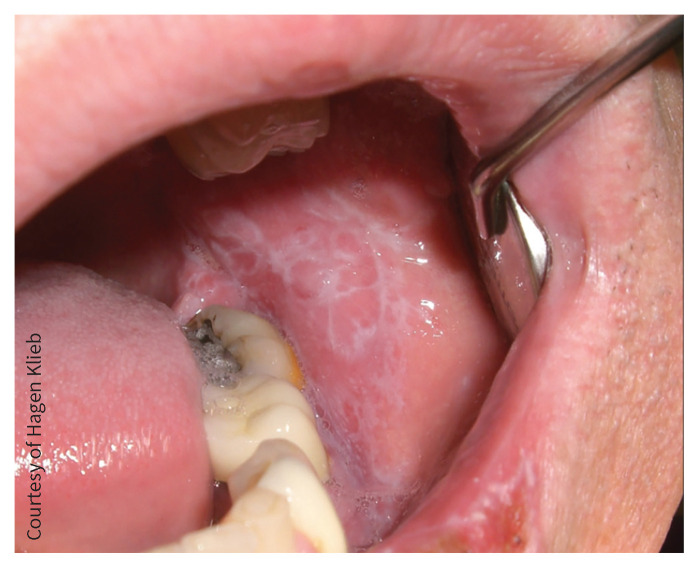The oral cavity is commonly the first site of presentation for lichen planus
Lichen planus is an immune-mediated inflammatory condition leading to characteristic lesions on skin and mucous membranes. It presents in up to 5% of the general adult population with a female predilection (2:1); the onset is most commonly in middle age.1,2 Up to 77% of patients with lichen planus have oral disease, with buccal mucosa the most common subsite.2 The oral lesions may be asymptomatic, although a subset of patients have pain and difficulty tolerating certain foods (e.g., acidic, spicy) and toothpaste.2
Oral lesions may undergo malignant transformation
Although oral lichen planus is a benign disorder, 1.4% of oral cavity lesions undergo malignant transformation within 7 years.3 Risk factors for malignant transformation include ulceration, location on the tongue and female sex.3
Some variants of oral lichen planus may resemble premalignant lesions such as erythroplakia and leukoplakia
The reticular form of oral lichen planus manifests with characteristic striated, lacy hyperkeratosis (Figure 1). However, other variants may have erythema (atrophic form) or ulceration (erosive form).4 The characteristic erythema of the atrophic form may be misinterpreted as erythroplakia, although the latter is often a well-demarcated solitary lesion.4 The plaque form, which appears as multiple white, homogeneous elevated plaques, may be mistaken for leukoplakic lesions (Appendix 1, available at www.cmaj.ca/lookup/suppl/doi:10.1503/cmaj.200309/-/DC1).2
Figure 1:
Classic keratotic reticular striae of the buccal mucosa in reticular-form oral lichen planus. Note that this pattern is often bilateral and symmetric.
Biopsy is reserved for noncharacteristic lesions
The diagnosis of oral lichen planus is often made based on characteristic clinical features (e.g., bilateral, symmetric striated hyperkeratosis).2 Biopsy may be necessary if there is clinical concern for dysplasia (e.g., weeks-old nonhealing ulcer) or to exclude immunobullous mimickers (e.g., mucous membrane pemphigoid).1
Symptom management is the mainstay of treatment
Asymptomatic lesions do not require treatment.2 However, annual follow-up to assess for transformation and self-resolution is warranted.2,5 For symptomatic patients, treatment involves maintaining oral hygiene; eliminating rough, jagged dental surfaces; and avoiding irritating foods. For substantial and lingering symptoms, topical corticosteroids (e.g., triamcinolone) are typically used. Topical calcineurin inhibitors, intralesional corticosteroid injections and systemic agents (e.g., prednisone) are reserved for recalcitrant cases.5
Footnotes
Competing interests: Antoine Eskander reports receiving research funds from Merck and consulting fees from Bristol Myers Squibb in 2019. No other competing interests were declared.
This article has been peer reviewed.
The patient has given written consent for the photograph to be used.
References
- 1.Cheng YS, Gould A, Kurago Z, et al. Diagnosis of oral lichen planus: a position paper of the American Academy of Oral and Maxillofacial Pathology. Oral Surg Oral Med Oral Pathol Oral Radiol 2016;122:332–54. [DOI] [PubMed] [Google Scholar]
- 2.Alrashdan MS, Cirillo N, McCullough M. Oral lichen planus: a literature review and update. Arch Dermatol Res 2016;308:539–51. [DOI] [PubMed] [Google Scholar]
- 3.Giuliani M, Troiano G, Cordaro M, et al. Rate of malignant transformation of oral lichen planus: a systematic review. Oral Dis 2019;25:693–709. [DOI] [PubMed] [Google Scholar]
- 4.Warnakulasuriya S, Ariyawardana A. Malignant transformation of oral leukoplakia: a systematic review of observational studies. J Oral Pathol Med 2016;45:155–66. [DOI] [PubMed] [Google Scholar]
- 5.Gupta S, Ghosh S, Gupta S. Interventions for the management of oral lichen planus: a review of the conventional and novel therapies. Oral Dis 2017;23:1029–42. [DOI] [PubMed] [Google Scholar]



